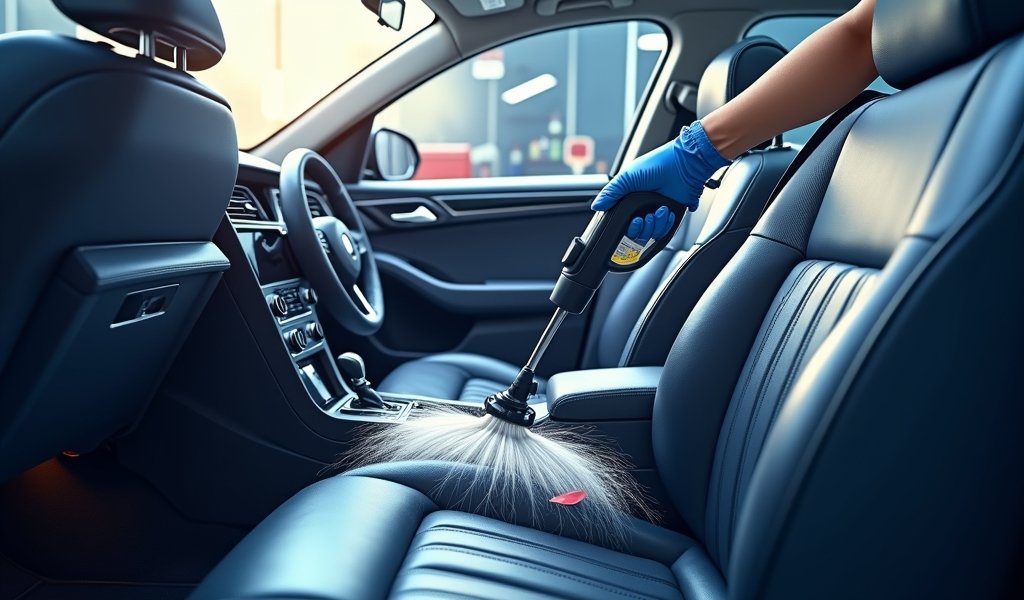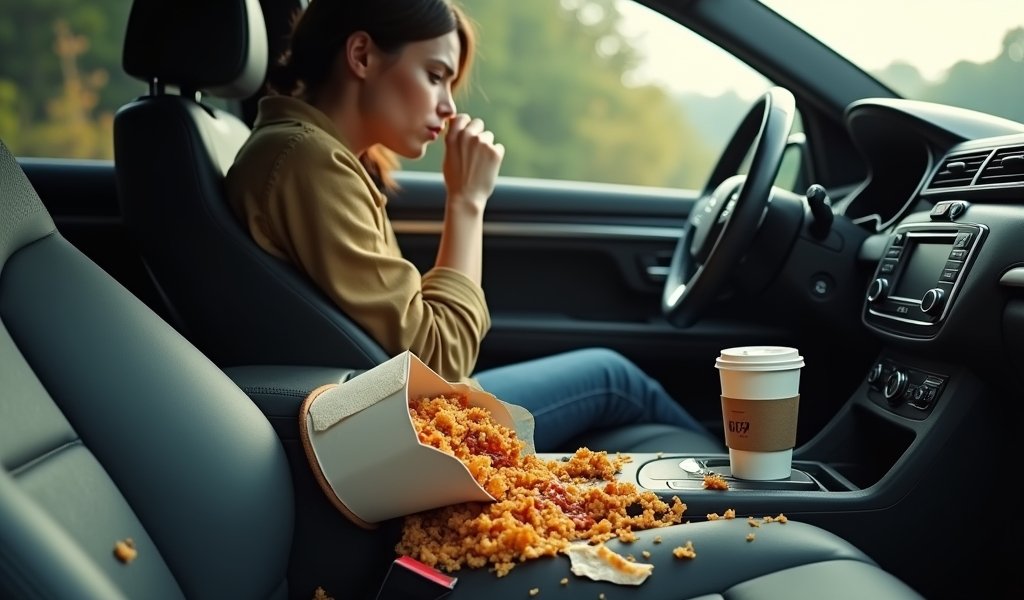Overview
This article provides a complete guide to eliminating food odors from vehicles, covering why smells linger, immediate remedies like baking soda and vinegar, deep cleaning techniques, specialized products, and prevention strategies. It offers both DIY solutions and professional options for different situations, from fresh spills to stubborn embedded odors, with practical advice for maintaining a fresh-smelling car interior.
Table of Contents
- Why Food Odors Linger in Your Car
- Immediate Steps to Banish Fresh Food Smells
- DIY Solutions for Persistent Food Odors
- Deep Cleaning Techniques for Stubborn Smells
- Specialized Products That Eliminate Food Odors
- Prevention Strategies: Keep Your Car Smelling Fresh
- When to Seek Professional Help
- Conclusion
- Frequently Asked Questions
Why Food Odors Linger in Your Car
Picture this: you’ve just finished a fragrant feast from your favorite drive-thru, and by morning, your vehicle has transformed into a four-wheeled food locker. The phantom french fries and ghostly garlic bread have left their aromatic autographs throughout your automobile’s interior. But why do these culinary clouds cling so stubbornly to your car’s cabin?
Your vehicle is essentially a sealed system of smell-absorbing surfaces. The plush fabric seats, porous carpeting, and countless crevices create the perfect playground for persistent food particles. Unlike your home with constant air circulation, your car becomes a concentrated capsule of captured aromas when closed up overnight or during hot days.
The science is simple: food odors contain microscopic particles that float through the air before settling on surfaces. In your car’s confined quarters, these odorous offenders have nowhere to escape, embedding themselves in fabrics and filtering through your ventilation system. Heat amplifies this effect – which is why that forgotten fast food feast can smell twice as potent after your car bakes in the summer sun.
Some of the worst offending foods include:
- Anything with garlic or onions (think burgers and pizza)
- Fried foods with lingering grease particles
- Fish or seafood dishes with their distinctive aroma
- Spilled dairy products that can sour quickly
- Foods with strong spices like curry or kimchi
When coffee splashes or smoothies spill, these liquids penetrate deep into carpets and upholstery, creating breeding grounds for bacteria that continue producing unpleasant odors long after the initial incident. Specialized cleaners for coffee spills can help tackle these particularly stubborn situations.
Immediate Steps to Banish Fresh Food Smells

When disaster strikes and your double cheeseburger does a double-flip onto your floor mats, swift action separates a temporary inconvenience from a long-term olfactory ordeal. The battle against food odors begins the moment the spill happens – and these first few minutes are critical.
First, remove all food containers, wrappers, and visible debris immediately. Those innocent-looking paper bags and food containers continue releasing odors long after the meal is finished. Check under seats, between cushions, and in door pockets where sneaky food fragments might be hiding.
For solid spills, start with dry cleanup methods:
- Use paper towels to blot up excess liquids without rubbing them deeper into fabrics
- Scoop up solid food particles with a plastic spoon or card
- Apply absorbent materials like salt or cornstarch to fresh grease spots
- Use a portable vacuum for crumbs and smaller particles
For liquid spills, time is truly of the essence. The deeper liquids penetrate, the harder they’ll be to remove completely. Blot aggressively with absorbent towels, applying pressure to extract liquid from carpet fibers or seat upholstery. Work from the outside edges inward to prevent spreading the spill.
Next, create a cross-breeze by opening all windows for at least 15-20 minutes. Fresh air circulation works wonders for dispersing airborne odor molecules. If possible, leave windows cracked overnight to continue the ventilation process – think of it as giving your car a chance to breathe out the bad scents.
For immediate odor counteraction, place a small container of coffee grounds, activated charcoal, or baking soda in your cup holder overnight. These natural odor absorbers begin working instantly to pull floating aroma particles from the air while you prepare for a deeper cleaning.
DIY Solutions for Persistent Food Odors
When fast food fragrance refuses to fade, it’s time to deploy the heavy artillery from your household supplies. These mighty makeshift methods can transform your mobile mess hall back into a pleasant driving environment without requiring specialized products.
The baking soda blitz is your first line of defense. This pantry powerhouse pulls odors from fabric fibers through absorption rather than masking them. Sprinkle it liberally across carpets and fabric seats, gently brush it in with a soft brush, then let it sit overnight. The next morning, vacuum thoroughly with a strong suction vacuum, and you’ll remove both the baking soda and the odors it trapped.
White vinegar works wonders through its ability to neutralize odors on a molecular level. Fill several shallow dishes with white vinegar and place them throughout your vehicle overnight with windows closed. The vinegar vapor will hunt down and neutralize odor molecules. For an enhanced effect, mix equal parts water and white vinegar in a spray bottle and lightly mist (don’t soak) your car’s fabric surfaces.
For leather and vinyl surfaces that have absorbed food odors, try this gentle cleaner:
- Mix one part white vinegar with two parts linseed oil
- Apply with a soft cloth using circular motions
- Buff with a clean dry cloth until no residue remains
Coffee grounds offer a two-for-one solution by absorbing existing odors while leaving behind a more pleasant coffee scent. Place dried used coffee grounds in paper cups or open containers around your vehicle overnight. The grounds work especially well for greasy food smells from burgers or french fries.
Citrus peels provide enzymatic odor elimination plus a fresh scent. Place fresh orange, lemon or lime peels in a container under your seat for a natural air freshener that actively battles food odors. Replace every few days until the unwanted smell subsides.
According to research from the American Chemical Society, these methods work because they either absorb odor molecules or neutralize them through chemical reactions – making them far more effective than simply masking smells with artificial fragrances.
Deep Cleaning Techniques for Stubborn Smells
When quick fixes fall short, it’s time to roll up your sleeves for a comprehensive cleaning assault on those stubborn food aromas. A thorough deep clean targets not just the surface scents but the hidden sources lurking in your car’s nooks and crannies.
Begin with a methodical vacuuming mission using attachments designed for auto interiors. Pay special attention to seat crevices, under seats, and along door pockets where food particles play hide-and-seek. Use the narrow attachment to vacuum air vents – a surprising harbor for odor-causing particles that recirculate whenever your fan system operates.
For fabric upholstery and carpets, an extraction cleaning provides professional-level results. You can rent extraction machines or use a portable carpet cleaner with auto attachments. The key is using the right solution – opt for enzymatic cleaners specifically designed to break down food proteins and oils. Apply the cleaner according to directions, then extract thoroughly, making multiple passes to remove as much moisture as possible.
Your headliner (car ceiling) often holds onto cooking odors, especially from steamy takeout containers. Lightly mist (never soak) with a fabric refresher made for automotive use, being careful not to damage the adhesive that holds the material in place. Use gentle circular motions with a microfiber cloth to distribute the product evenly.
Don’t forget these often overlooked odor hideouts:
- Seat belt webbing that absorbs food smells from your hands and clothes
- Door panel fabric that captures airborne food particles
- The underside of seats where spills can drip and remain undiscovered
- Air filter that may need replacement if saturated with food odors
For ventilation systems that circulate stale food smells, try this mechanic’s trick: Turn your AC to maximum with recirculation on, spray an automotive-safe disinfectant briefly into the external air intake (usually located near the windshield wipers), then run the system for 10-15 minutes. This helps clean the entire ventilation pathway and eliminates odors that have penetrated your ductwork.
Learning how to detail your car interior like a pro can save you hundreds on professional services while keeping your vehicle smelling fresh year-round.
Specialized Products That Eliminate Food Odors

When DIY remedies don’t quite cut through the culinary cloud in your car, specialized products formulated specifically for automotive odor elimination can provide the knockout punch your nose has been hoping for.
Enzymatic cleaners stand as the gold standard for food odor elimination. These biological wizards contain natural enzymes that actually consume the organic matter causing the smell. Unlike conventional cleaners that might clean the surface but leave odor-causing bacteria behind, enzymatic formulas break down the source materials completely. Look for brands specifically marketing their ability to tackle food spills rather than general purpose cleaners.
Activated charcoal odor eliminators work through adsorption – drawing and trapping odor molecules to their highly porous surface. These products come as bags or containers that you can place under seats or in rear compartments. The beauty of activated charcoal is its longevity – a quality product can work continuously for up to a year, and many can be “recharged” by placing in sunlight occasionally.
Molecular odor eliminators have revolutionized the battle against persistent smells. Rather than covering odors, these scientific solutions actually bond with odor molecules, changing their structure so they no longer trigger your olfactory receptors. They’re particularly effective against protein-based food smells like meat, cheese, and eggs that tend to linger stubbornly.
For those seeking a technological solution, consider a high-quality car air purifier with HEPA filtration. These devices actively pull air through multiple filtration layers, capturing even microscopic food particles that cause persistent odors. Models with additional activated carbon filters specifically target odor molecules for comprehensive air cleaning.
Ozone generators represent the nuclear option for extreme cases but require careful handling. These machines produce ozone that oxidizes odor molecules, breaking them down completely. However, they must be used in unoccupied vehicles following precise safety protocols, as ozone can be harmful to humans and pets when improperly used. According to the Environmental Protection Agency, ozone generators should be used with caution and proper ventilation.
Prevention Strategies: Keep Your Car Smelling Fresh
The sweetest victory against food odors is preventing them from taking hold in the first place. With some strategic habits and protective measures, you can enjoy on-the-go meals without transforming your vehicle into a mobile menu of lingering scents.
Start with a defensive foundation by applying fabric protectant to your cloth seats and carpets. These products create an invisible barrier that repels liquids and prevents them from penetrating deep into fibers where they become odor factories. Reapply every few months for continuous protection against food-related mishaps.
Invest in quality seat covers that can be easily removed and washed. Neoprene or weatherproof options provide excellent protection against spills while being simple to clean. For families with young children or frequent car diners, washable seat covers quickly pay for themselves in saved cleaning time and odor prevention.
Upgrade to all-weather floor mats with deep grooves and raised edges that contain spills rather than allowing them to seep into your carpeting. These can be removed and hosed off when food inevitably finds its way to your floor. The initial investment saves countless hours of carpet shampooing and deodorizing.
Develop these smart habits for car dining:
- Use cupholder liners that can be easily removed and cleaned
- Keep a small trash container with lid specifically for food waste
- Pack meals in sealed containers rather than paper wrappers
- Use straws with lids for drinks to prevent splashing
- Keep a small container of baby wipes specifically for quick hand cleaning
Consider designating certain foods as “car-friendly” and others as “home-only” based on their spill and odor potential. Foods like sandwiches, wraps, and fresh fruits generally pose lower risks than soups, saucy pastas, or anything requiring utensils.
Establish a quick clean routine after every meal in your vehicle. Take two minutes to collect all trash, wipe down surfaces with a disinfecting wipe, and check for fallen food bits. This tiny investment of time prevents small issues from becoming major odor problems down the road.
When to Seek Professional Help
Sometimes, despite your valiant efforts with vinegar vapors and baking soda barrages, food odors entrench themselves so deeply that DIY methods wave the white flag. Knowing when to call in the professionals can save you time, frustration, and ultimately restore your vehicle’s fresh atmosphere.
Consider professional intervention when these red flags appear:
- Odors persist despite multiple thorough cleaning attempts
- The smell seems to intensify when your heating or cooling system runs
- You detect musty or moldy notes suggesting liquid has penetrated to padding layers
- Spills involved milk, ice cream or other dairy products that may have seeped deeply into materials
- The odor returns within days after seemingly successful cleaning
Professional detailers bring specialized equipment that simply outclasses consumer options. Their commercial-grade extraction machines generate stronger suction and heat that pulls embedded food particles from the deepest carpet fibers. Steam cleaning systems deliver sanitizing temperatures that kill odor-causing bacteria lurking in upholstery.
Expert detailers also access professional-strength products not available to consumers. Their enzymatic cleaners contain higher concentrations of active ingredients, and they know precisely which formulations work best for specific types of food odors – from greasy burger remnants to spilled smoothies.
For truly stubborn situations, professionals can perform ozone treatments in controlled environments. This powerful oxidizing process breaks down even the most persistent odor molecules at their source. Because ozone can be harmful if used improperly, this treatment should only be performed by qualified professionals with proper equipment and safety protocols.
When selecting a detailing service for odor elimination, look specifically for shops advertising odor removal as a specialty rather than just general cleaning. Ask about their success rate with food odors specifically, and whether they offer any satisfaction guarantees for their deodorizing services.
Professional treatments typically range from $150-$300 for comprehensive interior detailing with odor elimination. While not inexpensive, when balanced against the daily discomfort of driving in a food-scented vehicle – or the potential hit to resale value – the investment often proves worthwhile.
Conclusion
Banishing food smells from your beloved vehicle doesn’t require a mechanical engineering degree or a magic wand – just a strategic approach with the right tools and techniques. By understanding why food odors cling so tenaciously to your car’s interior, you can tackle them at their source rather than simply masking them with temporary fragrance fixes.
Whether you’re dealing with yesterday’s drive-thru disaster or a long-term aromatic accumulation, the combination of immediate action, appropriate cleaning methods, and preventive measures provides a roadmap to olfactory victory. From the humble baking soda sprinkle to the mighty enzymatic cleaner, you now have an arsenal of options tailored to different situations and severity levels.
Remember that persistence pays off when battling stubborn smells. Some odors may require multiple treatment approaches or a combination of methods before they surrender completely. And for those truly stubborn situations, professional detailers stand ready with specialized equipment and expertise.
By incorporating some simple preventive habits into your daily driving life, you can dramatically reduce future food odor emergencies. Your vehicle represents a significant investment – keeping it smelling fresh not only enhances your daily driving experience but also helps maintain its value for years to come.
Now you can enjoy that occasional on-the-road meal without fear of permanent aromatic consequences. Your car deserves to smell as good as it looks – like a well-maintained machine, not last week’s lunch menu.
Frequently Asked Questions
How long do food smells typically last in a car?
Without intervention, strong food odors can persist for weeks or even months, especially in fabric surfaces. The timeline depends on the type of food, ventilation, and temperature conditions in your vehicle.
Will leaving my windows open eliminate food smells?
Open windows help but rarely eliminate odors completely on their own. Ventilation works best as part of a comprehensive approach that includes removing the odor source and cleaning affected surfaces.
Can car air fresheners remove food odors?
Most commercial air fresheners only mask odors temporarily rather than eliminating them. Look specifically for products labeled as “odor neutralizers” rather than simple fragrances for better results.
What’s the fastest way to remove fresh food smell from my car?
Immediate removal of all food containers followed by thorough ventilation and an absorbent like baking soda or coffee grounds works fastest. For severe cases, an enzymatic cleaner applied promptly can prevent odors from setting in.
Are ozone machines safe to use in my car?
Ozone generators can be effective but must be used with extreme caution. Never use them in occupied vehicles, and thoroughly ventilate the car before driving after treatment to prevent respiratory irritation.

